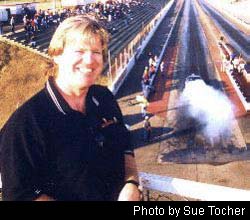
Too Quick for Comfort?

![]() nitially, I was just going to write an end-of-the-year, “Significant events of ‘06” type of column, but as I considered what to include, I kept coming back to a recent final-round pass that rewrote the record books and set a standard that may be difficult to duplicate—never mind exceed—any time soon.
nitially, I was just going to write an end-of-the-year, “Significant events of ‘06” type of column, but as I considered what to include, I kept coming back to a recent final-round pass that rewrote the record books and set a standard that may be difficult to duplicate—never mind exceed—any time soon.
The first inclination of savvy drag racing fans may be to think of ‘The Run,’ the Herculean effort put together for the last pass of the year by Alan Johnson and Tony Schumacher to wrest the NHRA Top Fuel championship away from Doug Kalitta, literally in the blink of an eye. That surely qualifies as a near-impossible-to-beat feat, and like most who witnessed it live or on TV, I remain in awe of the performance. But I’m thinking of something a little closer to home that I don’t feel has received the attention it warrants.
On November 12th, beneath a full moon, I stood just outside the left guardwall at Carolina Dragway watching and waiting for Tim Lynch and Jack Barfield to square off for the ORSCA Outlaw 10.5 final. Anticipation and expectations were high since a couple of rounds earlier Lynch had become the first 10-wide pilot to dip into the .30s over an eighth mile with a 4.39 at nearly 174 mph.
Conditions were ideal that weekend for Lynch’s twin-turboed, big-block Ford-powered ’02 Mustang to set the record: dropping ambient temperature, rising air pressure, and a track that was living up to its “House of Hook” nickname. Still, it didn’t come easy.
A snapped driveshaft during qualifying created more than a little consternation for the Lynch Mob, especially since it happened for the second time in their last three races. Upon further review, Lynch later confessed, “Our fault. We didn’t have the dowels in for lining the transmission up and it was trying to twist the transmission right out of the car.” Severe tire shake also plagued the team their last couple of outings, but chassis expert Hank Hill was
on hand at Carolina and, according to Lynch, helped sort out “99 percent” of the Mustang’s evil tendencies. “You can see the results,” he added.In the final, to back up his previous run within the required one percent for an official record, Lynch had to go 4.437 or quicker, or he could go as low as 4.350 for the .39 to serve as the back-up number. Most didn’t expect him to go quicker, though, as conventional wisdom dictated making sure he got down the track just fast enough to win and if the record came, well, so much the better.
He won all right, with an incredible 4.367-second pass at 172.87 mph. That wasn’t just resetting the record; that was redefining the class.
Lynch and crew chief Steve Petty, along with everyone at Proline Race Engines (where they both work), absolutely deserve all the recognition and kudos in the world. What they accomplished is truly remarkable, especially considering how just a couple of months earlier Steve Kirk stunned the Outlaw 10.5 world with a 4.43 during the ADRL’s Dragstock III at Rockingham, NC. Now it looks like low- to mid-.40s are going to become necessary for everyone just to remain competitive.
I won’t belabor the point of how much that level of performance will increasingly cost, but those kinds of numbers also should give rise to consideration of just how fast these cars should be going. Someone has to ask, is it time for speed controls to be imposed on Outlaw 10.5 just as they are in practically every other major drag racing series?
I know, I know. I can hear the outlaw faithful already gnashing their teeth and moaning and groaning about here I go again, trying to throw cold water on the class. But think about it; these cars are required to weigh at least 3,000 pounds, compared to, say, an NHRA Pro Stocker that posts similar eighth-mile speeds, but has to weigh just 2,450 pounds and runs on significantly wider (read: more stable) rubber out back.